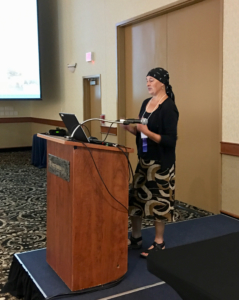Dr. Jennifer Brown, a Research Scientist Ethology with the Prairie Swine Centre said research shows that a range of strategies is useful for reducing aggression among group-housed sows.
In response to Canadian Pig Code of Practice changes which require gestating sows in group housing, researchers working on behalf of Swine Innovation Porc are exploring the social dynamics of group-housed sows.
Dr. Brown said the biggest challenge is the aggression of the sow.
“Certainly in the wild, we don’t see groups of pigs in general mixing at all. They are in very discrete groups and remain quite isolated throughout their life and don’t join with other groups of pigs,” she said. “We’re asking them, in our pens and barns, to work out their differences when they would prefer just to separate and be in different pens. Factors related to their levels of aggression would be familiarity, so sows that are familiar with other animals from previous gestations are going to be less aggressive towards one another because they are capable of recognizing each other.”
Dr. Brown said there’s certainly genetic selection which can help to choose animals that are going to be more passive and less aggressive when mixed in a group. “Then in our rearing practices, we can indeed work on ways of encouraging earlier socialization,” she said. “Some researchers have mixed pigs allowing litters to co-mingle at as soon as 12 days which is more of a natural age for pigs in the wild to socialize with other members of the group. Researchers have shown that initial mixing reduces aggression later on. Then, if you have gilts that you’re developing, mixing them multiple times, they will get used to developing social skills for adapting to changes in the group. Dr. Brown said producers can use those factors, as well as mixing practices to reduce aggression. When the new Code of Practice first came out, there was much consternation and worry amongst hog farmers and producer groups. Today it is even possible to walk into a room full of pregnant sows and get nary a squeal. How come?
“Usually, when you walk into a breeding area or gestation room when sows are noisy, it’s because, yeah, they’re expecting feed, and when people show up, it’s usually close to feeding time, and they’re expecting feed,” said Dr. Brown. “But in group housing, they don’t associate people with feed, and as long as they’re getting their daily feed ration, it doesn’t matter what’s going on, they are much calmer. And certainly being able to move around and choose a warmer area, or choose which sow they’re going to lie against, there’s obviously some social benefits to that.”
She said they’ve learned that sows are social animals, and there’s a lot of ways that the industry can manage them to improve their social interaction.
“We know they will fight when you mix sows with a new individual, but just understanding why they do that, and what we can do to reduce that aggression. I think we’ve got a lot of information in our pocket now, and now that feeding systems and pen design have taken that into consideration, it’s not a problem,” she said.
The days of a hog farmer getting the hammer, a two by four, a sheet of plywood and banging them together to make a hog barn are behind us.
“We’re certainly seeing a lot of nice new barns going up and even a lot of very decent renovations,” said Dr. Brown “If we have good times in the hog industry and a producer chooses to renovate, it’s a time to right-size your business. Sows are so productive now, maybe you don’t need as many sows, or maybe you do want to expand, but then you’re also going to expand your farrowing, and make a new farrowing room.”
She said to right size a barn and adapted to a lot of things, the fact that sows are bigger now than they used to be is a good thing. So, to combine that with the move to groups is just a positive thing for the industry, she thinks.
In conclusion, Dr. Brown said each producer must consider space allowance. “If you are cheap on space allowance, then you are going to end up with problems because when you’re managing sows in a group, they must have enough room that they can avoid one another if they want to. If you don’t provide enough space, then aggression is going to occur because they can’t prevent the bully. But if you give them sufficient space, which isn’t a lot of space, or add partitions and those sort of things, you can reduce any aggression that you’re going to see,” she said.
Flooring is very important. A producer should have floors that sows can move on freely, that they’re not going to catch their feet and that sort of thing, so that’s very essential. Also important is how the producer forms his groups, depending on the feeding system he’s using. •
— By Harry Siemens





